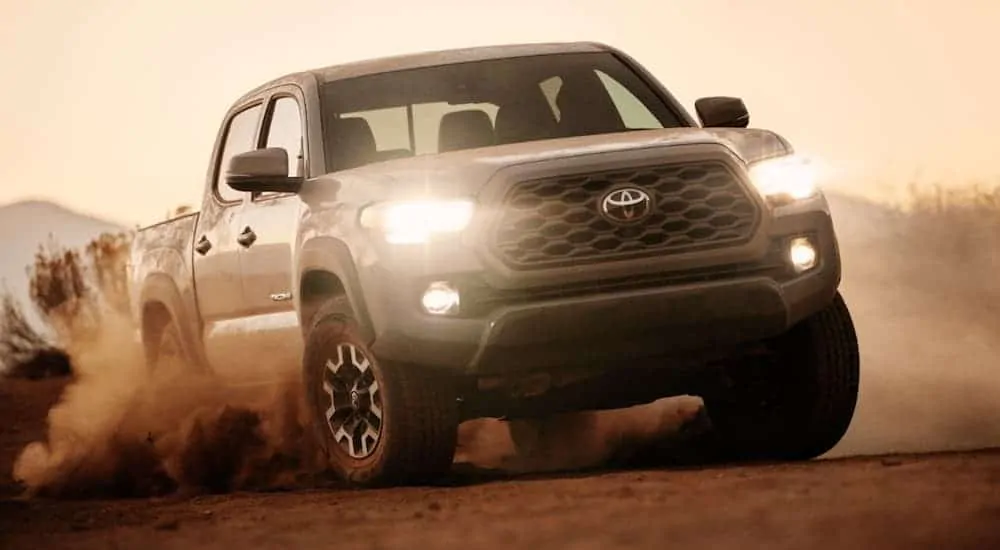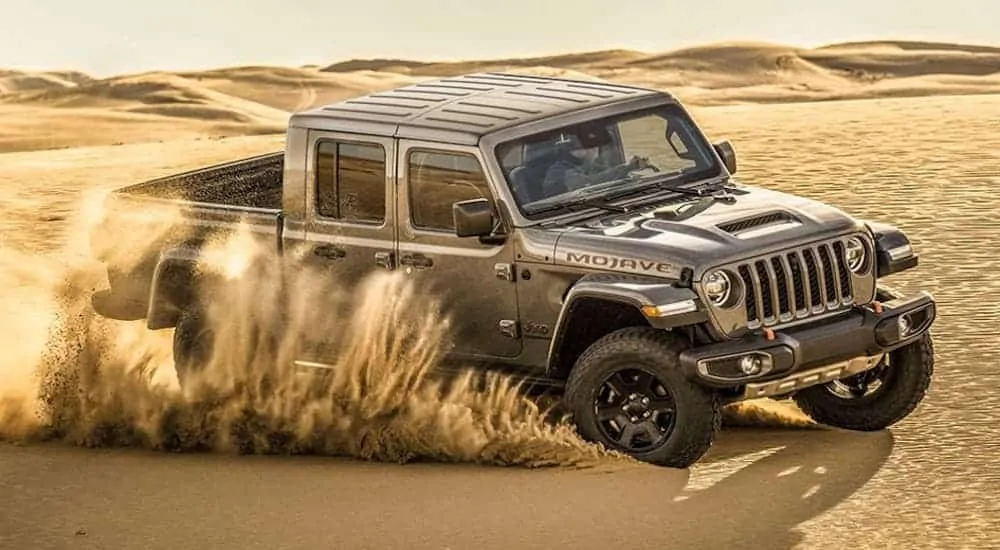Small trucks have really gotten more popular in recent years, with many folks seeing the utility in having a vehicle that can marry significant towing and payload capabilities, with the ease and comfort of driving a smaller vehicle than the larger pickup trucks available today. Let’s face it; not everyone is cut out to drive a heavy-duty truck, especially if it is loaded down with a significant cargo in its payload while towing a big trailer. This is especially true of us weekend warriors. In addition, a great number of small trucks have become the vehicle of choice for off-road enthusiasts who like the ability of a smaller vehicle to handle narrower trails. With this in mind, the folks at Fiat Chrysler America have added a new vehicle to the Jeep line for 2020, the Jeep Gladiator, which is like a pickup truck crossover of its popular Wrangler. So, how does it stack up to its competitors in the automotive coliseum? We sent one into battle recently against a key competitor in the small truck vehicle class, in the match-up between the 2020 Jeep Gladiator vs 2020 Toyota Tacoma.
Base MSRP and Trim Levels
The 2020 Toyota Tacoma has a base MSRP of $26,050. In contrast, the 2020 Jeep Gladiator has a base MSRP of $33,545. In addition, the Toyota Tacoma has six different trim levels. The entry-level is the SR, followed by the SR5 for an MSRP of $27,825, the TRD Sport for an MSRP of $32,745, the TRD Off-Road for an MSRP of $34,000, the Limited for an MSRP of $38,790, and the TRD Pro for an MSRP of $43,960.
The 2020 Jeep Gladiator has four trim levels. The Sport is the base model, followed by the Sport S for an MSRP of $36,745, the Overland for an MSRP of $40,395, and the Rubicon for an MSRP of $43,875.
Clearly, the initial price points are in Toyota’s favor, as it will cost $7,500 less to get behind the wheel of a Tacoma SR than a Gladiator Sport. However, the price for the top-of-the-line vehicle is the same. In addition, while Toyota has two additional trim levels, three of them, the TRD Sport, the TRD Off-Road, and the TRD Pro, are designed with off-roading in mind. All four trim levels of the Gladiator have strong off-road capabilities with the Rubicon adding specialized locking front and rear differentials to complete the package.

Engines and Performance Features
Both the 2020 Jeep Gladiator and 2020 Toyota Tacoma come with a standard engine across all trim levels, with an optional engine available. The 2020 Jeep Gladiator features a 3.6-liter V6 VVT engine with ESS (electronic start/stop). The ESS will automatically stop and then restart the engine in heavy traffic to conserve fuel. This engine can produce up to 285 horsepower and 260 lb-ft of torque. The Gladiator will also soon offer a 3.0-liter V6 Diesel as an engine option. This will provide 260 horsepower and an astounding 442 lb-ft of torque. All Jeep Gladiators have a 6-speed manual transmission standard, with an optional 8-speed automatic transmission.
The 2020 Toyota Tacoma comes equipped with a 2.7-liter DOHC 4-cylinder engine with VVT-i, which produces up to 159 horsepower and 180 lb-ft of torque. VVT-i stands for variable valve timing with intelligence. There is also a 6-cylinder engine available, a 3.5-liter V6 DOHC direct-injection Atkinson cycle engine with VVT-iW (which stands for variable valve timing with intelligent wide). This can produce up to 278 horsepower and 265 lb-ft of torque. All Tacomas feature 6-speed automatic transmissions.
Right off the bat, the Gladiator will have greater power and pickup than the Tacoma with the standard 4-cylinder engine. The only advantage of this standard engine is its strong fuel economy of 20 miles per gallon in the city and 23 miles per gallon on the highway. This is the only aspect that is better than the Gladiator’s engine, which has an estimated fuel economy of 16 miles per gallon in the city and 23 miles per gallon on the highway. Tacoma drivers could opt for the more powerful 6-cylinder engine, but this will increase the price of the truck and reduce the gas mileage to 18 miles per gallon in the city and 22 miles per gallon on the highway, which is fairly comparable to the Gladiator. Moreover, the Gladiator will still provide more power than the Tacoma. The Gladiator also has an advantage by offering a diesel engine, which will provide more torque than any of the other engines in either vehicle.
The Gladiator should also provide greater ride performance than the Tacoma since the Jeep is 4X4 standard. Drivers of the Tacoma will have to pay more if they want to go from the standard 4X2 to a 4X4. Finally, drivers of the Gladiator can choose between a manual and automatic transmission, with the latter providing an 8-speed transmission compared to the 6-speed transmission in the Tacoma transmission.
Towing and Payload
Both vehicles have been rated for towing and payloads, with differences depending on the choices drivers make when buying the vehicle. With the 2020 Toyota Tacoma, a great deal depends on the choice of engine. If the driver opts for the standard 4-cylinder engine, the Tacoma will only be able to tow a maximum of 3,500 pounds. Upgrading to the 6-cylinder engine will increase the towing capacity to between 6,400 and 6,800 pounds depending on trim level and drivetrain (4X4 versus 4X2), but will also increase the price of the Tacoma while decreasing fuel economy.
The towing capacity of the 2020 Jeep Gladiator depends on the trim level, since the standard engine is a very powerful 6-cylinder. The Gladiator Sport and Sport S can tow up to 7,650 pounds, while the Rubicon can tow up to 7,000 pounds. The only one that lags behind the Tacoma with a 6-cylinder engine is the Gladiator Overland, which has a maximum towing capacity of 6,000 pounds.
In addition, the Jeep Gladiator has the power and capacity to carry heavier loads. The maximum cargo capacity of the Gladiator is 1,700 pounds, fully 260 pounds more than the 1,440-pound cargo capacity of the Tacoma.
Passenger Space
The 2020 Jeep Gladiator comes in one standard two-row 4-door configuration and provides plenty of cabin space for its five passengers. The 2020 Toyota Tacoma comes in two configurations, a two-door Access Cab and a four-door Double Cab. Both have two rows of seats and can accommodate up to five passengers. Clearly, the Gladiator has more interior space for passengers.
First-row passengers in the Gladiator will enjoy 42.8 inches of headroom, 41.2 inches of legroom, and 55.7 inches of shoulder room, while second-row passengers also have 42.8 inches of headroom and 55.7 inches of shoulder room, with an acceptable 38.3 inches of legroom. While the Toyota Tacoma Access Cab and Double Cab provide adequate room in the first-row (39.7 inches of headroom, 42.9 inches of legroom, and 58.3 inches of shoulder room), the same cannot be said of the second-row. The Double Cab has a fairly tight 38.3 inches of headroom, 58.9 inches of shoulder room, and 32.6 inches of legroom. Things are even more cramped in the second-row of the Tacoma Access Cab, with only 34.9 inches of headroom, 56.5 inches of shoulder room, and 24.6 inches of legroom. Clearly, riding in the second-row of the 2020 Toyota Tacoma will not be a pleasant experience, particularly in an Access Cab on a long trip.
In short, the Gladiator will provide you with more space, more power, and is off-road-ready from the get-go.





